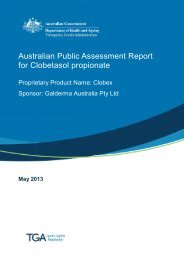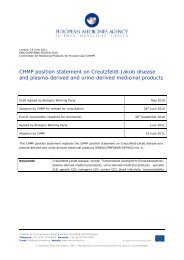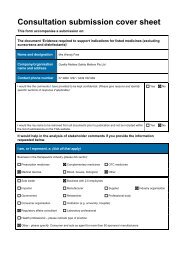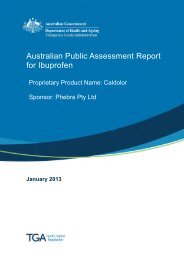AusPAR: Ivabradine - Therapeutic Goods Administration
AusPAR: Ivabradine - Therapeutic Goods Administration
AusPAR: Ivabradine - Therapeutic Goods Administration
You also want an ePaper? Increase the reach of your titles
YUMPU automatically turns print PDFs into web optimized ePapers that Google loves.
<strong>AusPAR</strong> Coralan <strong>Ivabradine</strong> Servier Laboratories (Australia) Pty Ltd PM-2010-03269-3-3<br />
Final 31 October 2012<br />
<strong>Therapeutic</strong> <strong>Goods</strong> <strong>Administration</strong><br />
years with HR ≥ 75 bpm at baseline” (N=856 [n=424 ivabradine, n=432 placebo]),<br />
“aged ≥ 65 years” (N=2464 [n=1265 ivabradine, n=1209 placebo]), “aged ≥ 65 years<br />
with HR ≥75 bpm at baseline” (N=1467 [n=721 ivabradine, n=746 placebo]) and the<br />
results are presented below together with the results in the overall study population<br />
in Tables 19 and 20. It is unclear why the HR criterion of ≥75 bpm was chosen. 36<br />
Table 19. Primary and main secondary endpoints in the overall population, in patients aged<br />
≥ 70 years and in patients aged ≥ 70 years with HR ≥ 75 bpm at baseline<br />
Table 20. Primary and main secondary endpoints in the overall population, in patients aged<br />
≥ 65 years, and in patients aged ≥ 65 years with HR ≥ 75 bpm at baseline<br />
The results showed that in the subgroup of patients aged ≥ 65 years, the relative risk<br />
reduction for the primary composite endpoint was not statistically significant.<br />
Similar to the results in the overall population, the mortality endpoints were mostly<br />
not statistically significant (only the endpoint of death from heart failure was<br />
statistically significant [relative risk reduction of 31%, p=0.0380]). Analysis in the<br />
endpoint of all-cause mortality showed there was no increased risk with ivabradine<br />
36 Sponsor comment: “The sponsor subsequently explained in its Pre ACPM response that the criterion of<br />
≥75 bpm was chosen because the EMA indicated in its evaluation of the SHifT study that ‘the baseline<br />
heart rate (HR) for patients with a positive benefit/risk balance may be higher than 75 bpm which could<br />
be considered as a relevant threshold in clinical practice.’ It is also the mean heart rate of the population<br />
included in the Euro Heart Survey conducted by the European Society of Cardiology. The sponsor<br />
considered the EMA’s advice and complementary analyses were subsequently performed to evaluate the<br />
efficacy and the safety of ivabradine treatment in this sub-group, ≥ 75 bpm. Therefore, the sponsor did<br />
not follow any specific methodology in arriving at a threshold of > 75 bpm.“<br />
Page 50 of 101
















